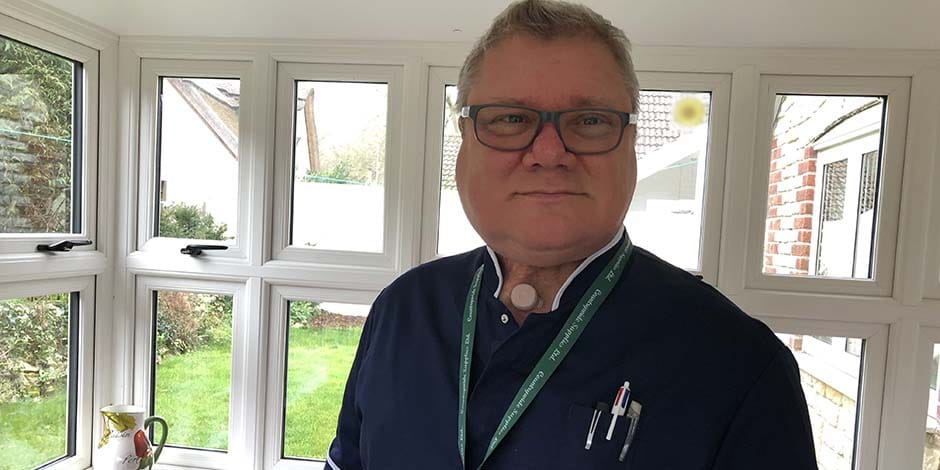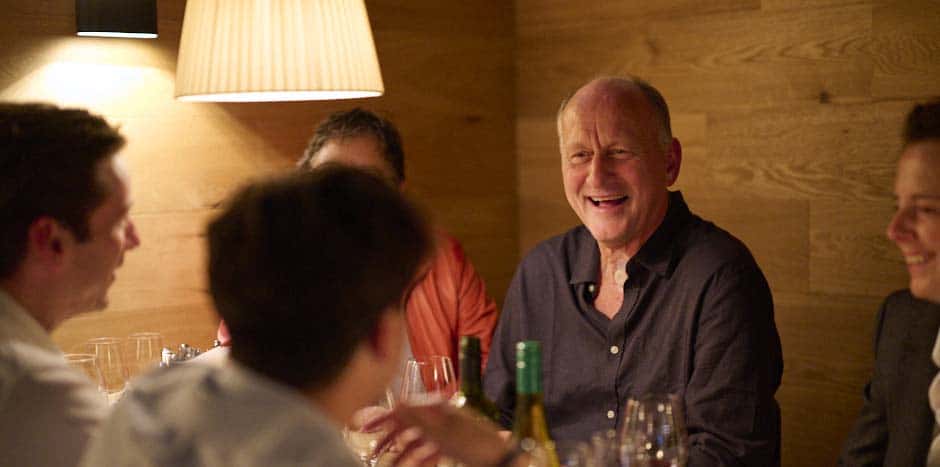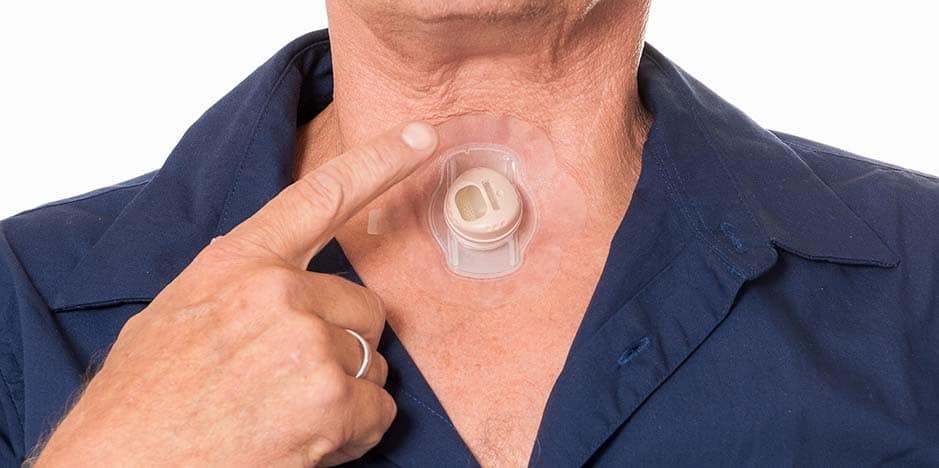Articles & Blog posts
Easy access
Make sure you can always access your favourite content by connecting My Content to your email.
Connect my emailAlready connected?
If you have already connected My Content to your email all you need to do is verify your email.
Verify my email05 September 2025
Voicing and life after a total laryngectomy
I had my laryngectomy exactly 8 years ago.

I had my laryngectomy exactly 8 years ago from when I started to write this piece of information. I hope the content will help you understand how your voice will be created and heard after you have had your surgery.
So you may be wondering how a laryngectomy will affect your voice after surgery? Before we delve into this let us look at what is voice and where does it come from. We can then move on to understand how we can regain our voice after surgery.
Simply put, voice is created through vibrations, the vibration to create your voice before surgery comes from your larynx. Air is pushed through the larynx thus causing the vocal chords to vibrate. This vibration creates voice.
The surgery redirects your windpipe to the hole in your neck so you will no longer be drawing air in through your mouth and nose as you always have. Instead, the air is inhaled and exhaled through the stoma. Also you have had your larynx removed so there are no vocal chords to vibrate to create your voice. So post surgery we have to create vibration that air interacts with to create a new voice. There are 3 types of voice that can be created after you have had your surgery:
- Oesophageal speech
- Electrolarynx speech
- Tracheoesophageal speech
Tracheoesophageal speech uses a voice prosthesis and esophageal speech use the upper part of your esophagus/food tube to produce the vibrations required to create sound for speech. Electrolarynx speech requires a device that electronically produces sound. You and your medical team will determine which method(s) is best for you. Whichever method you choose your voice will sound different to before surgery. However, most speak without much effort after undergoing training and with practice.
Tracheoesophageal speech uses a voice prosthesis and is the most common and natural sounding speech method used today. It is also considered the most successful method as it creates a more natural sounding, effortless voice. Your surgeon will create a tracheoesophageal puncture (TEP) between your trachea/windpipe and your esophagus/food tube and places a small silicone device called a voice prosthesis. This can be done during your laryngectomy or later once you are healed.
The voice prosthesis does not make the sound but allows air to travel from your lungs into your esophagus/food tube to produce sound. When you cover your stoma to speak, the air goes from your lungs through the voice prosthesis into your esophagus/food tube. The esophagus/food tube then vibrates and produces sound. That sound then travels to the mouth to shape it into speech. The voice prosthesis is a one-way valve that opens when you are speaking and closes when you are eating/drinking. The voice prosthesis will need to be changed on average every 2-3 months by either your doctor or your speech pathologist in their office. Learning to use your voice prosthesis can be quick and easy. You may be able to communicate well with very little effort the first time you try.
Most learn to use an electrolarynx/artificial larynx right after surgery in the hospital. It is an electronic device that produces sound that can be shaped into speech. The sound goes into your mouth either by placing the device up to your neck or cheek or by putting a small straw into your mouth. Once the sound is in your mouth, you then move your lips, teeth and tongue to shape that sound into speech to communicate. Some use this as their main way of speaking and others use it as a back-up device or to be heard in a noisy environment. It may take some time for others to understand you. However, with practice and training from your clinician, most are able to be understood.
Another way to speak after surgery is using oesophageal speech. Oesophageal speech uses the upper part of your oesophagus/food tube to make the sound. The way it works is that you push the air that’s in your mouth into your oesophagus/food tube with your lips and tongue. Your oesophagus/food tube then vibrates producing sound. That sound then travels into your mouth and you move your lips, teeth and tongue to shape that sound into speech. Oesophageal speech does not require a device or prosthesis. However, it can take time and patience to learn and has a lower success rate compared to other ways of communication.
Let us look at how our voice changes after surgery. There are a number changes to our voice after we have had surgery. Just to clarify I use tracheoesophageal speech to voice.
Clarity
You voice will sound different, if you use long sentences you may lose clarity in the words you are trying to say, so try and speak slowly and use shorter sentences.
Articulation
Some sounds, words or even letters can be less easy to produce and will require some training, for instance words that start with the letter H can be more difficult to say/pronounce
Linguistic features
Speech can become less varied both in tone and volume, so try and speak clearly and slowly
Breath support
This is a much bigger focus area and I will cover this later in the passage, the main take home from breath support is to learn how to use abdominal breathing, overtime you will do this without thinking about it, but you will need to learn
Volume
After your surgery it can be harder for you to be heard in noisy environments.
Stability
Your voice can be less stable at times especially if you are tired, you have been talking for long periods of time, also if you use tracheoesophageal speech remember to keep your voice prosthesis clean.
Flexibility
You will have fewer ways to use your voice, however you will adapt your voice to manage this flexibility.
Stamina
Because speaking after your surgery is an active action and uses abdominal breathing to enhance your voice you may become tired after talking for long periods of time.
Comfortability
You may feel uncomfortable when voicing after your surgery, try and be as relaxed as you can when you voice.
These are just some of the things you may have to consider when voicing after your surgery, the above list is by no means exhaustive
Throughout my own journey after my surgery I have considered all the above and still do on a daily basis. I consider my voice to be of good quality. People ask me why my voice is so good and the reasons are quite simple, I consider how my voice sounds taking all the above into account when I have a conversation with anybody. Before I go into a meeting, before I go out to dinner I practice voicing!
However, my journey was not plain sailing, over the years I have had to consider how my voice impacts various aspects of my life. I have had to learn how to accept how my voice will be received by others that I will be and am interacting with for the rest of my life. What follows is a number of these aspects that I had to consider or accept as I continue my journey. I will describe the various impacts and how I overcame them to live the best life I can.
Personality
I am a big chap, an ex-rugby player with a big personality .How am I going to retain the same personality after my surgery, I am known for my loud voice. Thankfully personality is not wholly due to your voice, it does support your personality though. My personality is not affected by my voice, personality is the whole person!
Accent
I am from the county of Lancashire, which is in the North West of England where people have very distinctive accents. I was pleasantly surprised to realise that after regaining my voice I actually retained my accent. This is because (and completely unknown to me before) accents are formed by mouth movements to create your accent, who knew?
Socialising
This was a big one for me, how can I socialize in larger groups where there are lots of people talking over everyone and creating a noisy environment. For a time I did not socialize, but there came a time where I felt this is not okay so when I go out with friends and family we always consider the environment and I will always sit in the centre of the group and will show my hand if I would like to make a comment as part of the conversation. This is understood by all my friends and family and has encouraged me to be social as much as I was before my surgery.
Income / Will I be successful?
This was an issue I took some time over. My initial thoughts were “how can I earn an income and provide for my family and can I be successful?” Once I was fully recovered from my surgery I had to consider my professional future. I have been a nurse for over 35 years and I knew I could not work in the environment I used to work. So I sat down and considered my options. Luckily I am in a profession that has many different working environments and I was able to work in the community instead of a busy ward environment.
Exercise
After my surgery I was not able to carry out much exercise due to getting breathless with minimal exertion. Over time I have regained the ability to exercise and with the help of HME’s that are designed for use whilst exercising I find I can do very much what I could do before my surgery.
Appearance
After my recovery and when I started to get back out in society I was very concerned that people could see my stoma, I felt eyes would go straight to my stoma before people would look at me. To combat this I took all my shirts to the seamstress and had clips sewn in to them so nobody could see the stoma and HME. This worked greatly, however after a time I realised that when I met people for the first time they would look at me with confusion and I could tell they were thinking “why does this person sound like this?” Also my family and friends would encourage me to open my shirt and they would remind me that this is who you are now! I would say after 2 years I also came to realise that this is me and people need to accept me as I am. I am not going to get rid of the stoma, it is with me for the rest I my life. So I had all the clips removed and it felt good, this is who I am and people do accept you, I also realised people will look at my stoma/HME because I am different. Having a laryngectomy is rare, previously in my nursing career I had met only one other person who had the same surgery as myself, people are naturally curious and in most very caring.
Sexual Wellbeing
I have included this into this piece of information as I think it is important to consider. When I first came home from hospital and during the early recovery phase of my journey this was not in my awareness/consciousness, however as time went by I did feel as though my physical attractiveness was affected by having a stoma in my neck. You the reader may think you are unattractive to your partner? My best advice is speak openly about your concerns with your partner and I am sure the response you will receive is that you are still the same person you were before your surgery!



